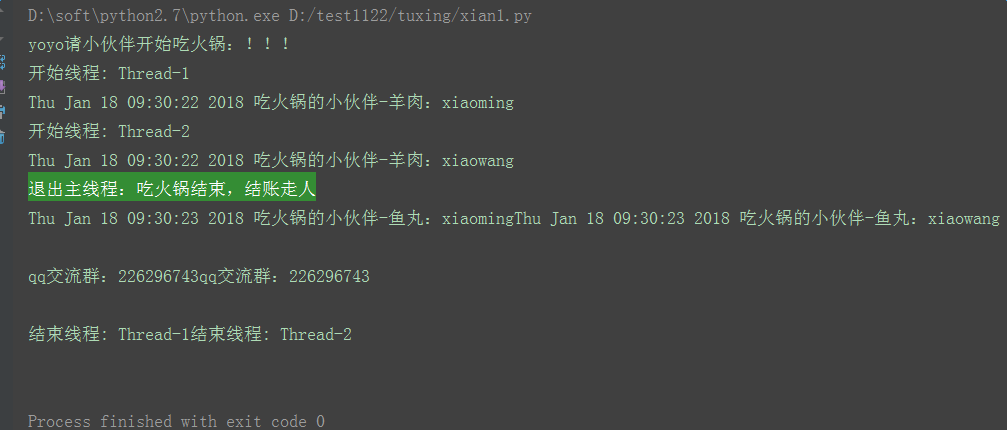python笔记9-多线程Threading之阻塞(join)和守护线程(setDaemon)
2018-01-18 10:22
651 查看
前言
今天小编YOYO请xiaoming和xiaowang吃火锅,吃完火锅的时候会有以下三种场景:场景一:小编(主)先吃完了,xiaoming(客)和xiaowang(客)还没吃完,这种场景会导致结账的人先走了,剩下两个小伙伴傻眼了。。。
场景二:小编(主)先吃完了,xiaoming和xiaowang还没吃饱,一起结账走人。
场景三:小编(主)先等xiaoming和xiaowang吃饱了,小编最后结账一起走人。
主线程与子线程
场景一:主线程已经结束了,子线程还在跑1.我们把thread1.start()和thread2.start()称为两个子线程,写在外面的代码就是主线程了。
# coding=utf-8
import threading
import time
def chiHuoGuo(people):
print("%s 吃火锅的小伙伴-羊肉:%s" % (time.ctime(),people))
time.sleep(1)
print("%s 吃火锅的小伙伴-鱼丸:%s" % (time.ctime(),people))
class myThread (threading.Thread): # 继承父类threading.Thread
def __init__(self, people, name):
'''重写threading.Thread初始化内容'''
threading.Thread.__init__(self)
self.threadName = name
self.people = people
def run(self): # 把要执行的代码写到run函数里面 线程在创建后会直接运行run函数
'''重写run方法'''
print("开始线程: " + self.threadName)
chiHuoGuo(self.people) # 执行任务
print("qq交流群:226296743")
print("结束线程: " + self.name)
print("yoyo请小伙伴开始吃火锅:!!!")
# 创建新线程
thread1 = myThread("xiaoming", "Thread-1")
thread2 = myThread("xiaowang", "Thread-2")
# 开启线程
thread1.start()
thread2.start()
time.sleep(0.1)
print("退出主线程:吃火锅结束,结账走人")2.运行结果:

守护线程setDaemon()
场景二:主线程结束了,子线程必须也跟着结束1.主线程中,创建了子线程thread1和thread2,并且在主线程中调用了thread.setDaemon(),这个的意思是,把主线程设置为守护线程,这时候,要是主线程执行结束了,就不管子线程是否完成,一并和主线程退出.
(敲黑板:必须在start()方法调用之前设置,如果不设置为守护线程,程序会被无限挂起。)
2.线程有一个布尔属性叫做daemon。表示线程是否是守护线程,默认取否。当程序中的线程全部是守护线程时,程序才会退出。只要还存在一个非守护线程,程序就不会退出。
主线程是非守护线程。
3.setDaemon(True)此方法里面参数设置为True才会生效
# coding=utf-8
import threading
import time
def chiHuoGuo(people):
print("%s 吃火锅的小伙伴-羊肉:%s" % (time.ctime(),people))
time.sleep(1)
print("%s 吃火锅的小伙伴-鱼丸:%s" % (time.ctime(),people))
class myThread (threading.Thread): # 继承父类threading.Thread
def __init__(self, people, name):
'''重写threading.Thread初始化内容'''
threading.Thread.__init__(self)
self.threadName = name
self.people = people
def run(self): # 把要执行的代码写到run函数里面 线程在创建后会直接运行run函数
'''重写run方法'''
print("开始线程: " + self.threadName)
chiHuoGuo(self.people) # 执行任务
print("qq交流群:226296743")
print("结束线程: " + self.name)
print("yoyo请小伙伴开始吃火锅:!!!")
# 创建新线程
thread1 = myThread("xiaoming", "Thread-1")
thread2 = myThread("xiaowang", "Thread-2")
# 守护线程setDaemon(True)
thread1.setDaemon(True) # 必须在start之前
thread2.setDaemon(True)
# 开启线程
thread1.start()
thread2.start()
time.sleep(0.1)
print("退出主线程:吃火锅结束,结账走人")4.运行结果:

阻塞主线程join(timeout)
1.如果想让主线程等待子线程结束后再运行的话,就需要用到join(),此方法是在start之后(与setDaemon相反)2.join(timeout)此方法有个timeout参数,是线程超时时间设置。
# coding=utf-8
import threading
import time
def chiHuoGuo(people):
print("%s 吃火锅的小伙伴-羊肉:%s" % (time.ctime(),people))
time.sleep(1)
print("%s 吃火锅的小伙伴-鱼丸:%s" % (time.ctime(),people))
class myThread (threading.Thread): # 继承父类threading.Thread
def __init__(self, people, name):
'''重写threading.Thread初始化内容'''
threading.Thread.__init__(self)
self.threadName = name
self.people = people
def run(self): # 把要执行的代码写到run函数里面 线程在创建后会直接运行run函数
'''重写run方法'''
print("开始线程: " + self.threadName)
chiHuoGuo(self.people) # 执行任务
print("qq交流群:226296743")
print("结束线程: " + self.name)
print("yoyo请小伙伴开始吃火锅:!!!")
# 创建新线程
thread1 = myThread("xiaoming", "Thread-1")
thread2 = myThread("xiaowang", "Thread-2")
# 开启线程
thread1.start()
thread2.start()
# 阻塞主线程,等子线程结束
thread1.join()
thread2.join()
time.sleep(0.1)
print("退出主线程:吃火锅结束,结账走人")运行结果:

参考代码:
# coding=utf-8
import threading
import time
def chiHuoGuo(people):
print("%s 吃火锅的小伙伴-羊肉:%s" % (time.ctime(),people))
time.sleep(1)
print("%s 吃火锅的小伙伴-鱼丸:%s" % (time.ctime(),people))
class myThread (threading.Thread): # 继承父类threading.Thread
def __init__(self, people, name):
'''重写threading.Thread初始化内容'''
threading.Thread.__init__(self)
self.threadName = name
self.people = people
def run(self): # 把要执行的代码写到run函数里面 线程在创建后会直接运行run函数
'''重写run方法'''
print("开始线程: " + self.threadName)
chiHuoGuo(self.people) # 执行任务
print("qq交流群:226296743")
print("结束线程: " + self.name)
print("yoyo请小伙伴开始吃火锅:!!!")
# 设置线程组
threads = []
# 创建新线程
thread1 = myThread("xiaoming", "Thread-1")
thread2 = myThread("xiaowang", "Thread-2")
# 添加到线程组
threads.append(thread1)
threads.append(thread2)
# 开启线程
for thread in threads:
thread.start()
# 阻塞主线程,等子线程结束
for thread in threads:
thread.join()
time.sleep(0.1)
print("退出主线程:吃火锅结束,结账走人")
相关文章推荐
- Java多线程 小知识 守护线程(后台线程)setDaemon、join方法、优先级、yield方法
- Python setdaemon守护进程
- python 多线程中的守护线程与join的用法
- python学习笔记——线程threading (二)重写run()方法和守护进程daemon()
- python中thread的setDaemon、join的用法
- Daemon(守护与否)和join(阻塞与否)
- Java学习笔记73. 后台线程与setDaemon( )方法
- 守护线程 python 笔记
- java的调度、优先级setPriority、yield、jion和守护线程setDaemon
- 从头认识多线程-1.17 守护线程setDaemon()
- java停止线程 interrupt 和守护线程setDaemon
- Python中threading的join和setDaemon的区别及用法[例子]
- python中thread的setDaemon、join的用法
- JAVA——守护线程或用户线程(setDaemon)
- Python 线程,用类实现多线程,join阻塞主线程
- setDaemon(true)后就是后台线程(守护线程 ),反之就是前台线程(用户线程)
- python中thread的setDaemon、join的用法
- 利用setDaemon(true)设置守护线程
- python 多线程中的守护线程与join的用法
- python多线程编程以及join,setDaemon,线程锁的用法
